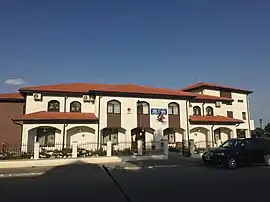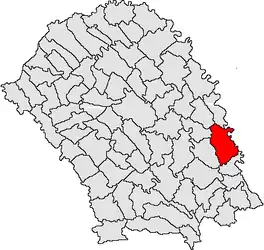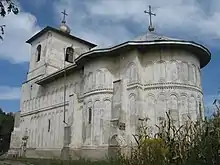Ștefănești | |
|---|---|
 Ștefănești Town Hall | |
 Coat of arms | |
 Location in Botoșani County | |
 Ștefănești Location in Romania | |
| Coordinates: 47°47′29″N 27°11′57″E / 47.79139°N 27.19917°E | |
| Country | Romania |
| County | Botoșani |
| Government | |
| • Mayor (2020–2024) | Florin Buțura[1] (PNL) |
| Area | 96.58 km2 (37.29 sq mi) |
| Elevation | 67 m (220 ft) |
| Population (2021-12-01)[2] | 5,032 |
| • Density | 52/km2 (130/sq mi) |
| Time zone | EET/EEST (UTC+2/+3) |
| Postal code | 717385 |
| Area code | (+40) 02 31 |
| Vehicle reg. | BT |
| Website | orasulstefanesti-bt |
Ștefănești (Yiddish: שטעפנשט, Hebrew: שטפנשט) is a small town in Botoșani County, Western Moldavia, Romania. It administers four nearby villages: Bădiuți, Bobulești, Stânca and Ștefănești-Sat.
The town is located near the point where the Bașeu River discharges into the Prut River, on the shore of the Stânca-Costești reservoir. Stânca is a border checkpoint with Moldova, connected via the Stânca-Costești Dam to the town of Costești, Moldova.
Demographics
According to the 2021 census, Ștefănești has a population of 5,032.[3] At the census from 2011, the town had a population of 5,092; of those, 90.57% were ethnic Romanians and 9.3% ethnic Romani.[4]
Natives
The painter Ștefan Luchian (1868–1916) was born here, as well as Vlad Onicescu, the father of the mathematician Octav Onicescu (1892–1983). The town is also the birthplace of the Shtefanesht Hasidic dynasty and as such its name is still known in present-day Israel.
References
- ↑ "Results of the 2020 local elections". Central Electoral Bureau. Retrieved 6 June 2021.
- ↑ "Populaţia rezidentă după grupa de vârstă, pe județe și municipii, orașe, comune, la 1 decembrie 2021" (XLS). National Institute of Statistics.
- ↑ "Populația rezidentă după grupa de vârstă, pe județe și municipii, orașe, comune, la 1 decembrie 2021" (in Romanian). INSSE. 31 May 2023.
- ↑ "Structura Etno-demografică a României". Edrc.ro. Retrieved 8 October 2017.


